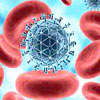Parasites And Disease
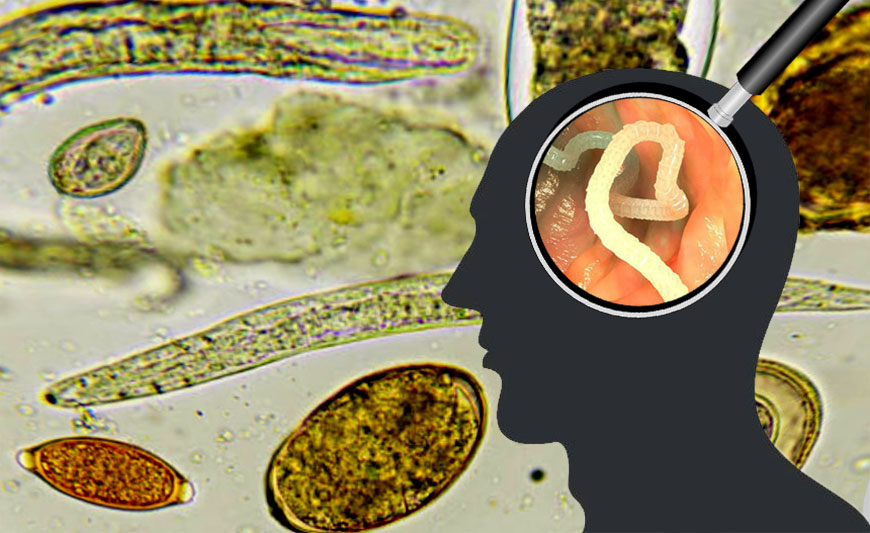 by Barbara Abeler
by Barbara Abeler
WHAT ARE PARASITES?
A human parasite would be any sort of foreign, microscopic organism that essentially uses your body to breed and survive. Intestinal parasites are organisms that live in your digestive tract. Although not strictly a bowel disorder, parasites thrive in an unhealthy, unclean intestine. When the bowel contains partially digested proteins, it can harbor an amazing variety of harmful bacteria and parasites.
New research shows that parasites not only control the behavior of their hosts, they can change entire ecosystems to suit their needs. According to the World Health Organization, 3.5 billion people suffer from some type of parasitic infection. Many live in the United States.
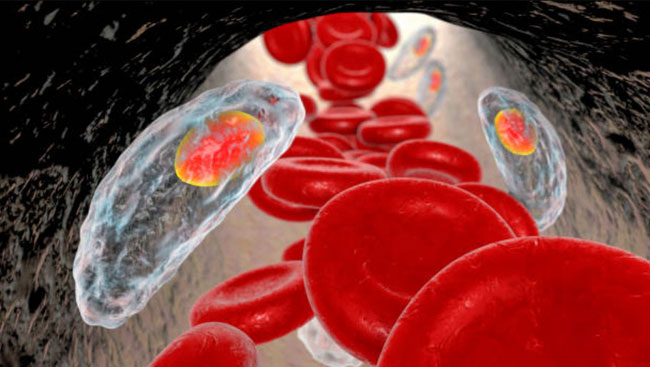 WHY SHOULD I CARE ABOUT PARASITES?
WHY SHOULD I CARE ABOUT PARASITES?
Virtually all parts of our bodies will host some type of parasite within our lifetimes. Parasitic infestation of the bodies of humans has reached epidemic proportions, representing a major health challenge that is often overlooked by medical professionals. There is a tendency to only treat the symptoms—chronic fatigue, skin rashes, muscle and joint pain, weakened immune system, forgetfulness, food allergies, colitis, water retention, and many others—without considering that parasites may be the root cause of health problems. Most doctors are not trained to recognize the symptoms associated with parasitic infections. The only way to avoid the problems associated with parasite infections is by educating yourself. Self health means keeping yourself healthy. Doing it yourself!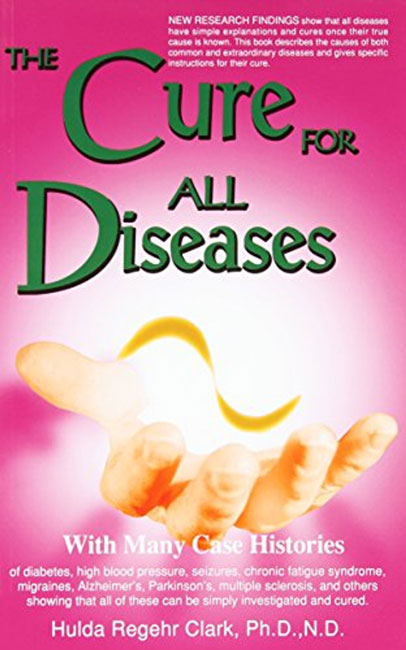
Dr. Hulda Clark, Ph. D., N.D. states in her book, The Cure For All Diseases, “No matter how long and confusing the list of symptoms a person has, from chronic fatigue to infertility to mental problems, I am sure to find only two things wrong: they have in them pollutants and/or parasites. I never find lack of exercise, vitamin deficiencies, hormone levels or anything else to be a primary causative factor.”
Many people take bottles and bottles of the best nutritional supplements, but then can’t understand why they don’t work. Often this is because the parasites are getting the best nutrients! You get the “scraps and leftovers” while they grow healthy and fat and your organs starve for nutrition. A silent battle is waging at all times within your body – a battle between YOU and the PARASITES! You swallow the food and they get the good out of it. Maybe this is the reason you have never felt great in spite of eating the most nutritious meals.
Click “Watch On Youtube” For The Continuing Playlist
BASICALLY PARASITES CREATE DAMAGE TO THE HOST’S BODY IN SIX WAYS:
1. They destroy cells in the body faster than cells can be regenerated, thereby creating an imbalance that results in ulceration, perforation, or anemia.
2. They produce toxic substances that are harmful to the body. In cases of chronic infection, the body’s immune response can be pushed into overdrive, producing elevated levels of eosinophils. Eosinophils are specialized white cells that normally combat any microscopic pathogen, but when their level is elevated, they themselves can cause tissue damage that results in pain and inflammation.
3. The presence of parasites irritates the tissues of the body, inducing an inflammatory reaction on the part of the host.
4. Some parasites invade the body by penetrating the skin, producing dermatitis. During their developmental stage, other parasites perforate and damage the intestinal lining.
5. The size and/or weight of the parasitic cysts, particularly if they are located in the brain, spinal cord, eye, heart, or bones, produces pressure effects on these organs. Obstruction, particularly of the intestine and pancreatic and bile ducts, can also occur.
6. The presence of parasites depresses immune system functioning while activating the immune response. This can eventually lead to immune system exhaustion.
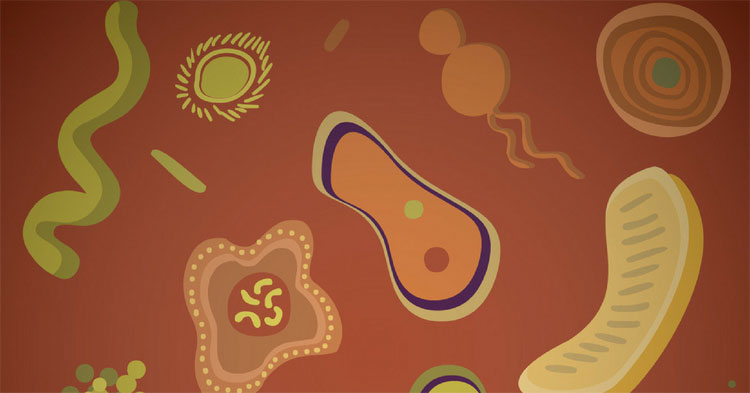 MICROSCOPIC PARASITES CAN LIVE IN EVERY ORGAN OF THE BODY AND CONTRIBUTE TO JUST ABOUT ANY DISEASE:
MICROSCOPIC PARASITES CAN LIVE IN EVERY ORGAN OF THE BODY AND CONTRIBUTE TO JUST ABOUT ANY DISEASE:
♦ Microscopic parasites can get into your joints and eat the calcium linings of the bone. This can lead to arthritis.
♦ Parasites can eat the protein coating on the nerves (myelin sheath). This causes a disruption in the nerve signal from the brain.
♦ Many times when a person has an inflamed appendix, it is removed and found to be loaded with parasites.
♦ They can make Swiss cheese out of your organs. Worm infections can cause physical trauma by perforating (burrowing) the intestines, the circulatory system, the lungs, the liver or the whole body.
♦ Parasites give off metabolic waste products that poison our bodies. Most have trouble disposing of the toxins that are re-absorbed through the intestines. Your body has to work twice as hard to remove these toxic waste products.
♦ They can erode, damage, or block certain organs by lumping together in balls or tumors. They can be mistaken for cancer tumors, and travel into the brain, heart, and lungs.
NOT ALL PARASITES ARE MENACING
Some living things that park themselves on or in our bodies actually perform a service. One example is the relatively harmless tooth amoeba. Brushing your teeth won’t drive these tiny squatters out; they run for cover when they see a toothbrush, then happily emerge to feast on microscopic bits of food or other organic material. This kind of relationship between host and parasite is called “mutualism”. Another less than dangerous parasite is the dust mite. Although they can cause allergies, dust mites operate as a sort of cleanup crew for our skin. They march about on our skin and scalps all day, scarfing up dead skin cells. Combine the invisible guests such as worms and bacteria with visible ones like fleas, ticks, mosquitoes, lice and flies—all of whom feed on human blood or tissue—and it’s easy to get a little paranoid about being host to an army of parasites!
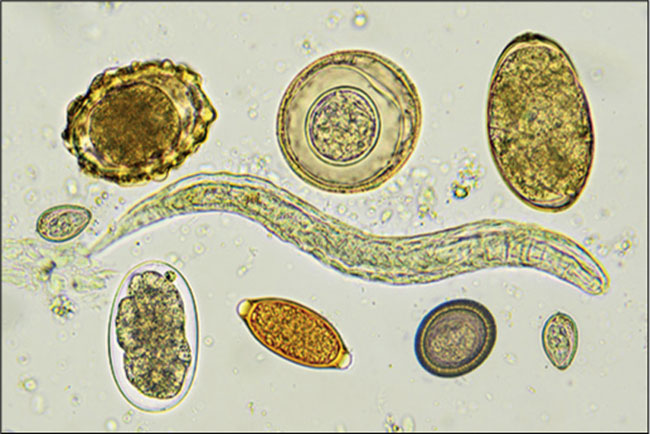 TYPES OF PARASITES AND HOW THEY AFFECT US?
TYPES OF PARASITES AND HOW THEY AFFECT US?
The following is a list of the different types of worms and parasites that have been identified in humans. It is hypothesized that everyone has all of them in different layers of the colon. First, parasitic worms are divided into roundworms and flatworms.
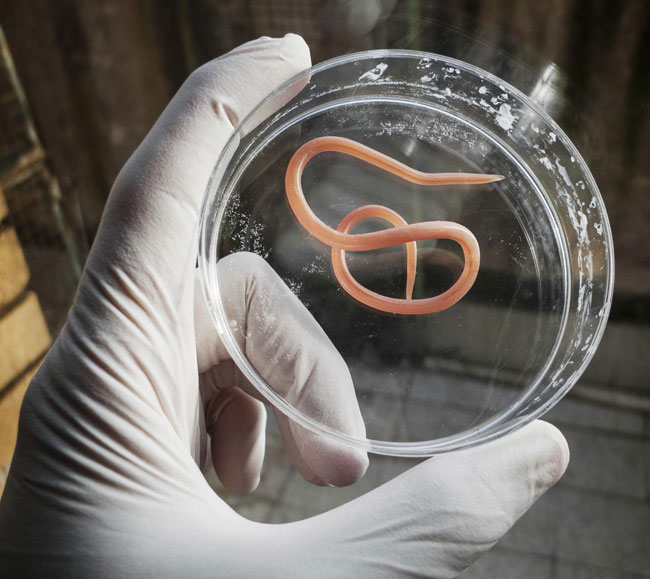 ROUNDWORMS
ROUNDWORMS
Roundworms are long thread-like parasitic worms that cause infections of the digestive tracts in humans. Roundworm infection is very common the world over and, in very severe cases, can prove fatal. The infection is mainly spread by a lack of adequate hygienic and sanitation methods; for example:
– failing to wash hands before eating or before touching the mouth,
– failing to wash fruit and vegetables before eating,
– eating raw or uncooked meat or seafood,
– playing or working in soil that is contaminated,
– having pets that are infected with roundworms.
Roundworm eggs, once ingested reach the digestive tract and release larvae. These larvae perforate the intestinal wall and enter the liver and bloodstream and move toward the lungs. From the lungs, the larvae move into the upper lung passages and airway. They are swallowed and returned to the intestine where they now mature, can grow up to 12 to 14 inches, reproduce, and release up to 20,000 eggs a day. The infected person suffers from stomach pain, cramps, and nausea. The overgrowth of roundworms can lead to intestinal blockage or rupture. Other symptoms are asthma, eye pain, insomnia, and rashes due to the secretions or waste products from the worms.
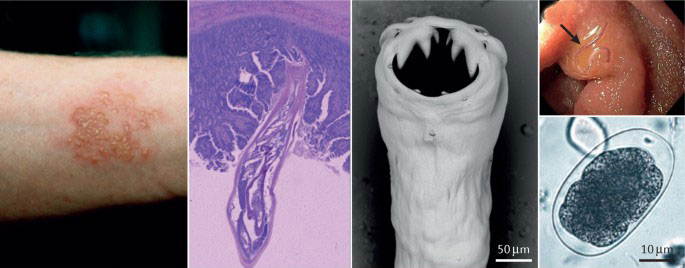
HOOKWORMS
Hookworms are an ugly type of roundworm that are vicious. One species of this parasite is called Necator Americanus or American 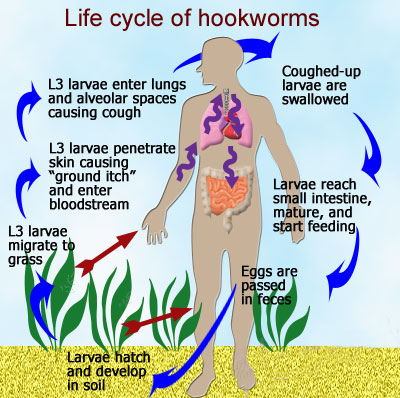 Murdered. The other species that commonly affects humans is Ancylostoma duodenale. Hookworm larvae penetrate the skin of any person who comes in contact with them. This is commonly caused by walking barefoot through areas contaminated with fecal matter. The larvae are able to penetrate the skin of the foot. After entering the body, the larvae travel through the bloodstream to the lungs and then are swallowed and enter the digestive tract. In the digestive tract they mature into adult worms. They mate inside the host, females laying up to 30,000 eggs per day and some 18 to 54 million eggs during their lifetime. Because it takes 5-7 weeks for adult worms to mature, mate, and produce eggs, in the early stages of very heavy infection, acute symptoms might occur without any eggs being detected in the person’s feces. This can make diagnosis very difficult. When hookworms reach adulthood, they can sap the victim’s strength, vitality, and overall well-being. Young worms use their sharp teeth to burrow through the intestinal wall and feed on your blood.
Murdered. The other species that commonly affects humans is Ancylostoma duodenale. Hookworm larvae penetrate the skin of any person who comes in contact with them. This is commonly caused by walking barefoot through areas contaminated with fecal matter. The larvae are able to penetrate the skin of the foot. After entering the body, the larvae travel through the bloodstream to the lungs and then are swallowed and enter the digestive tract. In the digestive tract they mature into adult worms. They mate inside the host, females laying up to 30,000 eggs per day and some 18 to 54 million eggs during their lifetime. Because it takes 5-7 weeks for adult worms to mature, mate, and produce eggs, in the early stages of very heavy infection, acute symptoms might occur without any eggs being detected in the person’s feces. This can make diagnosis very difficult. When hookworms reach adulthood, they can sap the victim’s strength, vitality, and overall well-being. Young worms use their sharp teeth to burrow through the intestinal wall and feed on your blood.
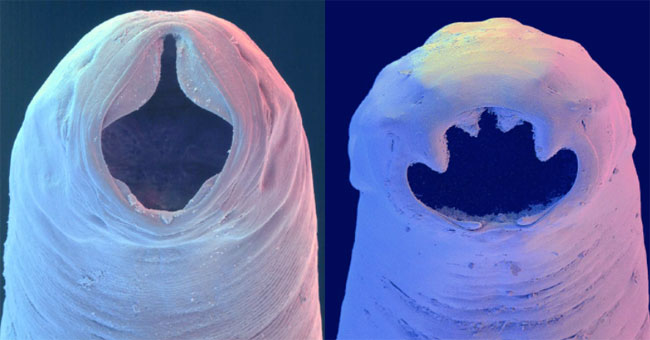 These curved critters are about 6” long. They come to a point at both ends and are shaped like a fishhook. They are gray in color. One quarter of the world’s population has hookworms, including 50% of Americans.
These curved critters are about 6” long. They come to a point at both ends and are shaped like a fishhook. They are gray in color. One quarter of the world’s population has hookworms, including 50% of Americans.
Symptoms of hookworm are iron deficiency (anemia), abdominal pain, loss of appetite, or capricious appetite, craving to eat soil, protein deficiency, dry skin and hair, skin irritations, edema, distended abdomen, obstinate constipation followed by diarrhea, stunted growth, delayed puberty, mental dullness, cardiac failure, and death. Larval invasion of the skin might give rise to intense, local itching, usually on the foot or lower leg, which can be followed by lesions that look like insect bites, can blister, and last for a week or more.
 PINWORMS
PINWORMS
Pinworms are extremely common intestinal parasites. It’s hard to avoid pinworm infestation because their eggs are often airborne. The eggs can survive about two days anywhere in your living environment. Symptoms are itching and irritation of the anus or vagina, digestive disorders, insomnia, irritability or nervousness. Once pinworms are snugly ensconced inside the human body, the female worms crawl out of the anus at night and can lay about 15,000 eggs on bedding or sleepwear. Pinworms can infect one in five children. These tiny little parasites wiggle when they come out. They are about ¾” and live in the intestine. At least one in five children has pinworms.
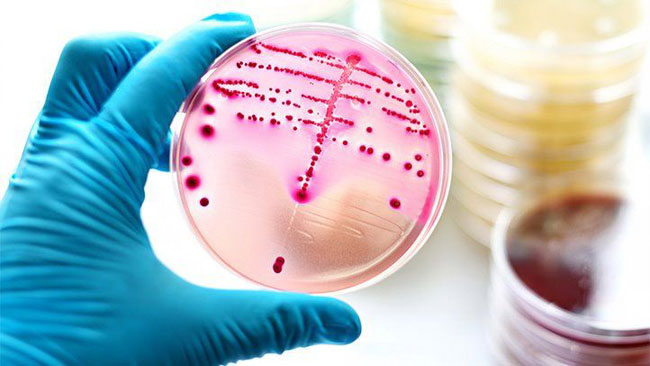 A final note on roundworms…
A final note on roundworms…
According to Hulda Clark, the parasites that cause pain (joint pain, arthritis, fibromyalgia) are not the large ones, like worms or amoebas. Nor are they the tiny viruses. They are the bacteria. Bacteria are the right size to get into the doorways of our cells. For bacteria to get all over your body, they must be riding along with parasites that get all over your body. Microscopically tiny roundworms can do this. The wormlets bring hosts of bacteria with them, mainly “Streps” (Streptococcus varieties) and “staphs” (Staphylococcus varieties), but also “Clostridiums” (Clostridium varieties) and “Campyls” (Campylobacter varieties). The bacteria are probably the pain causers. By killing the parasites and bacteria in every household member and the pets at the same time and by never putting your fingers to your mouth, you can expect permanent pain relief.
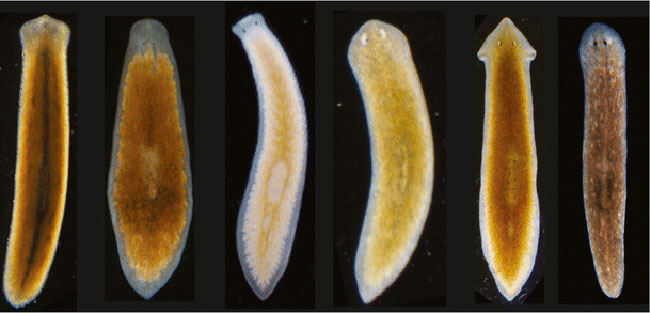 FLATWORMS
FLATWORMS
Flatworms are more like leeches. They have a way to attach themselves sometimes with the head (scolex) like tapeworms, sometimes with a special sucker-like flukes.
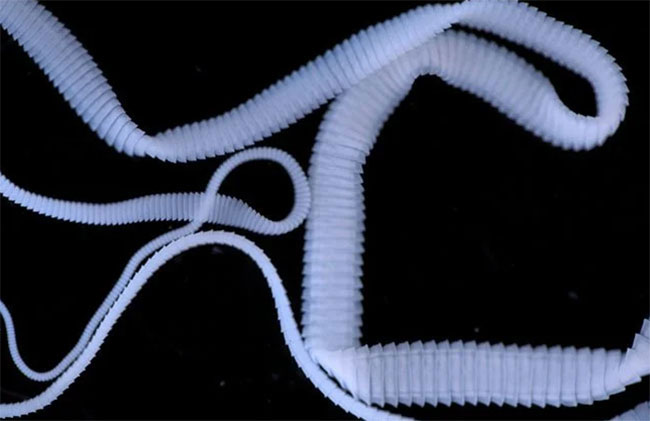 TAPEWORMS
TAPEWORMS
When we are always hungry we may jokingly say that we have tapeworms. However there is nothing funny about tapeworms. These huge parasites may be more than 50 feet long and are capable of producing a million plus eggs a day and can survive as long as 20 years. Tapeworms consume so much food that the host may actually be hungry all the time, yet may appear obese because of the tapeworm-induced water retention. Some tapeworms attach themselves to the walls of your intestine, where they cause irritation or mild inflammation, while others may pass through to your stool and exit your body.
In humans, tapeworm disease is most commonly caused by one of several tapeworm species: the pork tapeworm (Taenia solium), beef tapeworm (Taenia saginata), dwarf tapeworm (Hymenolepsis nana), and fish tapeworm (Diphyllobothrium latum) from raw freshwater fish.
Eggs are usually ingested through food, water, or soil contaminated with human or animal feces. After hatching, the tiny larva burrows into its favorite organ. Your body encases it with a cyst. The white blood cells have been taught never to attack your body…and the cyst case is your body! So the tapeworm stage has safe residence for some time. If you are a meat eater, you could eat such a cyst if it happens to be lodged in the meat you are eating. Your teeth break it apart as you crunch. The little larva is swallowed and tries to attach itself to your intestine with its head. Then it grows longer by making segment after segment.
As well as the intestinal tract, a serious form of this disease is when the larvae infect the central nervous system called neurocysticercosis which is very serious possibly causing seizures and is potentially life-threatening.
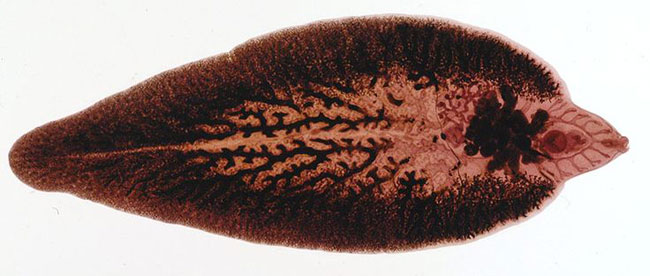 FLUKES
FLUKES
Flukes are so named because their bodies are flat in cross-section. They have flat, leaf-shaped, un-segmented bodies. They normally have a pair of suckers – an oral and ventral one – which help the fluke hang on to the part of the body in which they live.
Human infections of flukes can cause severe disease of the gastrointestinal tract, bladder, liver, and destroy blood cells. Size varies from 1 to 2.5 centimeters in length to 3 inches long. They have a complex life cycle with many stages.
Four fluke varieties are:
• intestinal fluke
• sheep liver fluke
• pancreatic fluke of cattle
• human liver fluke
Don’t let the terms sheep and cattle mislead you. They are all found in humans. The liver fluke has a dark red pigment, much like the liver in which it lives. Liver and lung flukes are tiny, almost transparent gel-like looking parasites that have a dot in the center that is like their head or their brain or the nucleus of what they are.
The eggs passed out with bowel contents were not meant to be eaten as such. They were meant to hatch in a pond where snails and minnows eat them. The larva grows up in these new “secondary” hosts. Later the snail sheds them and they attach themselves near foliage near the pond. They over-winter in a tough metacercarial cyst. An unsuspecting browsing animal now eats them. They come out of their metacercarcial cyst as a small adult and quickly attach themselves to the intestine with a sucker. They now have a “safe haven” and can go about maturing and laying eggs.
Dr. Hulda Clark says, “Fasciolopsis buskii is the fluke that I find in every case of cancer, HIV infection, Alzheimer’s, Crohn’s disease, Kaposi’s, endometriosis, and in many people without these diseases.” She has found a relationship with different solvents in the body and flukes: isopropyl alcohol, benzene, methyl ethyl ketone, wood alcohol, xylene and toulene. The life cycle of the fluke has six stages. The adult fluke is the only stage that “normally” lives in the human (and then only in the intestine). But when your body has solvents in it, the other five stages can develop in you.
The outward signs of infection are usually the abdominal symptoms (discomfort, nausea, diarrhea) associated with the inflammation of the gut wall caused by the presence of the parasite. Large numbers of the flukes may obstruct the flow of materials in the intestine. They may also grow large and block the bile ducts where they lay their eggs, which can lead to jaundice and other liver complications. Blood flukes generally live in the veins draining the abdominal organs – the mesenteric veins and the portal vein. They attach themselves to the walls of the blood vessels by means of their suckers and, after mating, lay their eggs into the blood stream. The eggs pass down the blood vessels until they become too large to proceed. Most eggs have a spine or knob which shears through the wall of the blood vessel like a can opener. Aided by muscle movement from the host, the egg gradually works its way through the tissue until it passes out with the feces or urine.
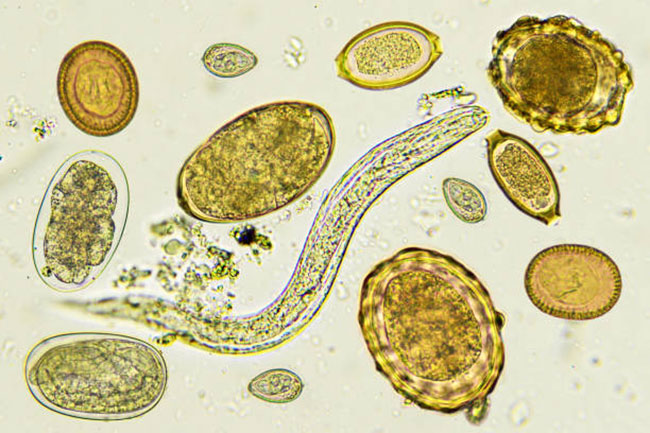 ADDITONAL TYPES OF PARASITES
ADDITONAL TYPES OF PARASITES
Whiteworms. These come in all sizes. They are often the color of eggshells and look like spaghetti. They turn black when they grow up.
Redworms. These look just like the earthworms you see in the ground. They come out of the colon wrapped in balls. They can be as long as 6 to 7” in length.
Inchworms. These are thick, black, and bumpy. They are as thick as fountain pens and about 2” long.
Blackworms. These are 1” to 12” in length. They come out of the colon wrapped around each other with yellow acid water mixed with them. They live deep in the impacted colon wall.
Little Fish. These are a type of parasite with a round head and tail. They actually swim as they come out of the colon. In many cases they will try to swim back up the colon. They come out in schools and are ½” long. Virtually everyone has these!
Threadworms. These parasites are as thin as a thread. They are cream-colored and often come out by the hundreds.
Fuzzballs. These are parasites that are round and have fur on them. Many cancer patients have these. They are ¼” to ¾” in diameter.
Spiders. These are a type of parasite that look just like a spider. They often have many legs and are colored brown. Some look like an octopus. They are often 1” long.
Stickpin worms. These are still another type of parasite that looks like a stickpin. They are 1” long and have a head like a pea, which is perfectly round. The babies are white and the adults are black.
Some parasitic worms have the ability to fool bodies into thinking they are a normal part of the tissue or organ and the immune system will not fight off the intruders. Another factor that has contributed significantly to the growing parasite epidemic is the widespread use of drugs that suppress immunity as a side effect. Many of the drugs in common use today are immunosuppressive and therefore increase our susceptibility to parasitic infestation.
Parasites sometimes come out of people by the litter. They nest in the black, impacted colon. As one layer is cleaned, a certain type of worm comes out. Another layer brings out another type of worm. It is recommended that people go on a parasite cleansing program a few times a year.
Although many external factors contribute to the parasite problem, by far the biggest factor is an internal one: a toxic colon.
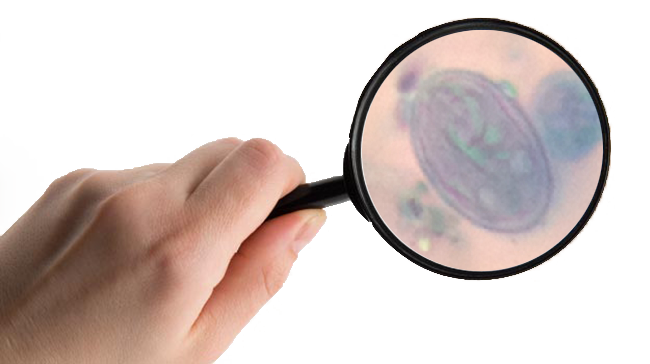 HOW ARE PARASITES DIAGNOSED?
HOW ARE PARASITES DIAGNOSED?
Stool samples are one way to diagnose parasites, but as stated earlier, in the early stages, they will not be found in the stool and if your parasites are in your heart or lungs, they will not show up in your stool. Specialized testing is often needed to detect parasites that can be difficult to spot as they go through different stages of their life cycles.
A “string test” can be done where a capsule that is attached to a string, one end of which is left outside the mouth is swallowed. After a few hours, the string is withdrawn and examined microscopically. An invasive approach is to obtain a tissue specimen through a biopsy taken with an endoscope. Blood tests can be used to reveal an elevated eosinophil count, a general indicator for an infection by parasites.
A specialized blood test, the ELISA (Enzyme-Linked Immunosorbent Assay), can be used to diagnose giardia and possibly other parasites. Other types of blood tests, sputum tests, urine tests and even radiologic tests can be used to detect various types of parasites with varying degrees of success. Analysis of aspirated fluids and growth of tissue cultures may also be used.
Holistic practitioners such as naturopaths can detect exactly the type(s) of parasites you have using various forms of bioenergetic testing. Every organism has a frequency and with the right equipment the characteristic frequencies can be measured and the parasite detected. It has been discovered that even dead creatures have a resonant bandwidth.
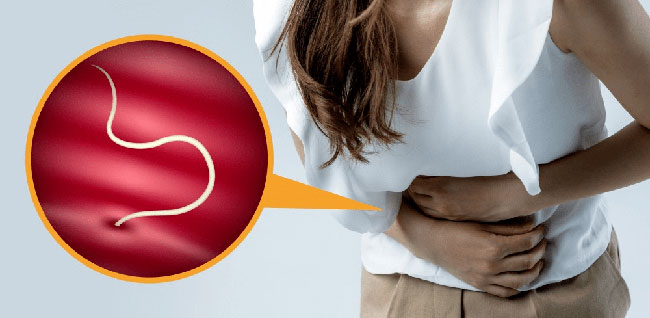 SIGNS & SYMPTOMS
SIGNS & SYMPTOMS
Medical texts don’t have much to say about parasites other than stating that they can cause diarrhea and mal-absorption. As mentioned earlier, it is important to bear in mind that parasites can mimic other disorders and/or produce no noticeable symptoms. When they DO cause symptoms, a wide range can be displayed. These can include:
♦ Diarrhea or constipation ♦ Headaches/neck aches
♦ Low-grade fever ♦ Dark circles under eyes
♦ Apathy, depression ♦ Prostatitis
♦ Light sensitivity ♦ Coughing
♦ Sugar cravings ♦ Itchy anus or ears
♦ Weight loss (or gain) ♦ Teeth grinding
♦ Irritability/nervousness ♦ Persistent skin problems
♦ Nose picking ♦ Elevated white blood cells
♦ Overall fatigue ♦ Disturbed sleep
♦ Nail biting ♦ Muscle cramps
♦ Brain fog ♦ Joint pain
♦ Pain in the umbilicus ♦ Post nasal drip
♦ Bed wetting ♦ Swollen glands
♦ Mucus in stools ♦ Food and environmental sensitivities
♦ Foul-smelling stools ♦ Ravenous appetite or loss of appetite
♦ Depressed secretory IgA (an antibody) ♦ Back aches
♦ Digestive complaints, (gas, bloating, cramps, nausea, vomiting)
♦ Granulomas (tumor-like masses that encase destroyed larva or parasites)
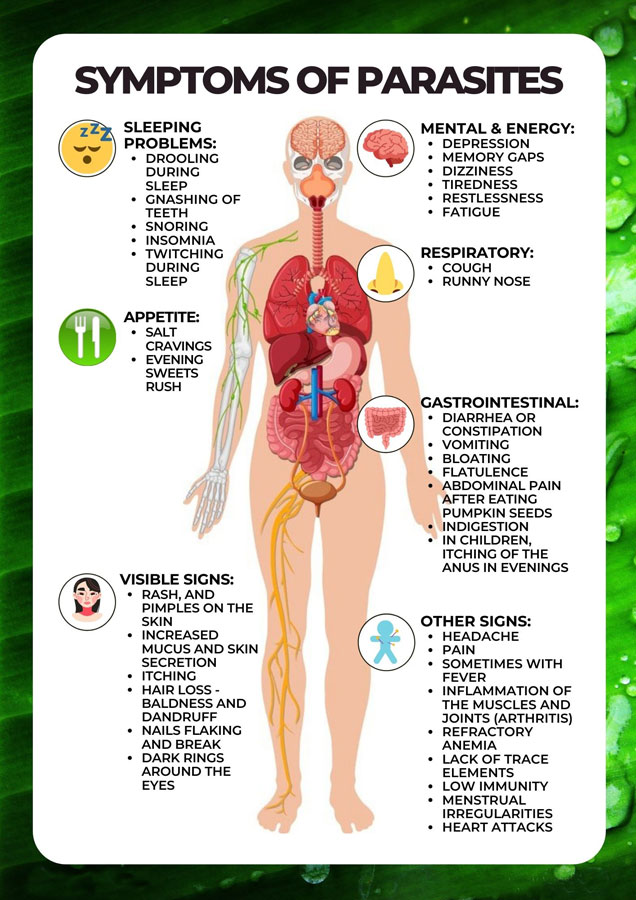 Parasites can affect tissue anywhere in the body. Some of the disorders that have been associated with them include:
Parasites can affect tissue anywhere in the body. Some of the disorders that have been associated with them include:
♦ arthritis ♦ appendicitis
♦ allergies ♦ recurrent yeast infections
♦ anemia ♦ bronchitis
♦ flu ♦ asthma
♦ irritable bowel syndrome ♦ lactase deficiency
♦ frequent colds and infections ♦ fibromyalgia
♦ gallbladder problems ♦ urinary tract infections
♦ malnutrition ♦ prostatitis
Over time, a parasite infection can depress immunity and cause leaky gut syndrome, which leads to nutritional absorption problems and has been associated with allergies and other autoimmune diseases.
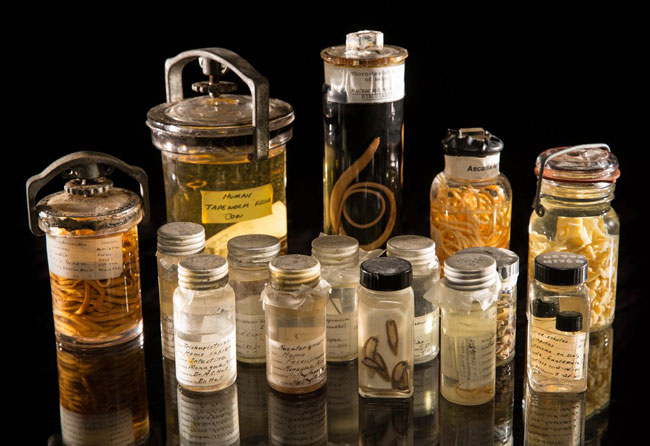 GET THESE THINGS OUT OF ME!
GET THESE THINGS OUT OF ME!
Parasites are both under-diagnosed and under-treated in standard medical circles simply because the average medical doctor is not aware of their prevalence. When parasites are detected, they are most often treated with drugs, despite many drug adverse side effects and the fact that some parasites have become drug-resistant.
So what can you do?
Plan of Attack Phase 1: KILL ALL PARASITES
- Starve them and pull them out! 7-day fasting cleanse using Montmorillonite Clay – everything unhealthy, that emits negative radiations is irresistibly attracted to clay and becomes subject to immediate elimination—it would be best to do this twice/year.
- Hulda Clark’s Parasite Cleansing Protocol, 20 day kit using three herbs which can rid you of over 100 different types of parasites– Black Walnut Green-Hull tincture, Wormwood Tincture, Cloves Tincture.
- Remedies from Naturopathic Medicine.
- Other parasite cleansers.
- Electrocute them! The theory is that the positively offset frequency kills all bacteria, viruses, and parasites simultaneously. The ERE (electro reflex energizer) takes 21 days, 15 minutes/day to be sure to get them all.
- Colon Hydrotherapy – has been known to cause them to come out as clients have viewed them in the tube. In addition, once the parasites are killed, one must cleanse the body so that the dead parasites can be eliminated.
- Liver/Gallbladder Flush – sweeping your liver clean is the most powerful way of helping your body to heal itself after the parasites are gone. There are thousands of bits of “trash” accumulated in the liver bile ducts.
Plan of Attack Phase 2: PREVENT REINFESTATION
- Build the immune system – a healthy immune system is the best defense against parasites.
- Regular healthy bowel movements (1-2x/day) and colon hydrotherapy–when we have toxic substances in the colon seeping into the body tissues, it’s like having a time release poison in your bowel.
- Acupuncture, massage, chiropractic, naturopathy.
- Diet – Candida Diet – both Candida and parasites tend to travel together. Organic vegetables and meat, no refined carbohydrates or sugar (including fruit), focus on alkaline foods, high fiber, juicing, add garlic, pumpkin seeds, and cloves, properly combine foods.
- Supplements – maintenance herbal remedy, digestive enzymes, EFA’s (essential fatty acids), probiotics – a minimum of 2-6 billion cultures, antioxidants.
 LIFESTYLE – the following are but a few suggestions:
LIFESTYLE – the following are but a few suggestions:
♦ drink purified or filtered water
♦ have pets tested for parasites
♦ deworm pets
♦ wash hands after using the toilet
♦ wash hands after changing a baby’s diaper
♦ wash hands after handling raw meat
♦ wash hands – before eating, after gardening, after changing kitty litter
♦ wipe kitchen counters with disposable towels – not rags or sponges
♦ don’t eat raw meat or fish
♦ make sure meat is thoroughly cooked
♦ wash vegetables and fruits in a diluted hydrogen peroxide/vinegar bath
♦ use separate cutting boards for meats/fish & fruits and vegetables
♦ freeze fish for 48 hours (beef & pork for 24 hours) before preparing – this will kill any parasite larvae
♦ protect children from animal droppings
♦ don’t let kids use sandboxes where animal droppings may be found
♦ check for parasites regularly
♦ do a parasite cleanse once or twice yearly
♦ do a liver/gallbladder cleanse every two months until stones clear
♦ keep hands away from mouth
♦ clean or keep short fingernails – parasites can live for two months under the fingernails
♦ do not walk barefoot on warm, moist soil or while working in the garden
♦ avoid swallowing or drinking water while swimming anywhere
♦ avoid swimming if cuts or open sores are present
♦ do not overuse antibiotics – this reduces the numbers of friendly bacteria in the colon
. . .YOU CAN WIN THE BATTLE!
 Hulda Clark Collection For Dealing With Parasites
Hulda Clark Collection For Dealing With Parasites
Herbal-Parasite-Cleanse-Recipe
Posted in Health, Other Topicswith comments disabled.





